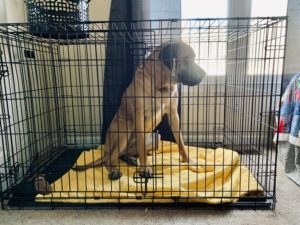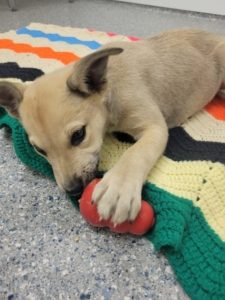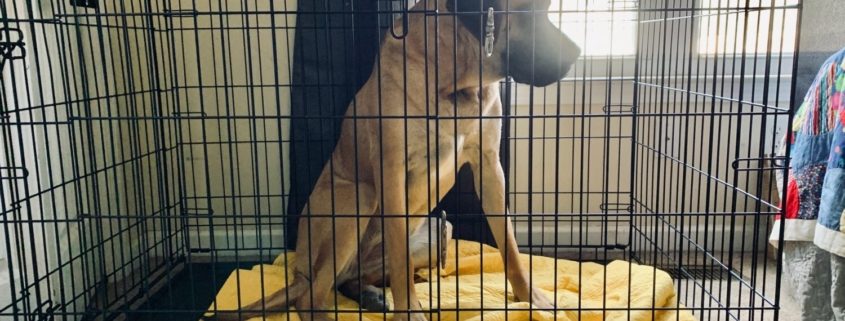Ask Crystal: How to Make the Crate Great!

Dear Crystal,
I have a 6-month-old puppy. He will be calm and collected in the crate as long as he sees me or my partner. If he doesn’t see any of us, he will begin to bark nonstop. He also is very destructive with anything we give him to keep him busy in the crate. I honestly don’t know if he has separation anxiety or doesn’t enjoy being in the crate. It could also be a mix of both.
Thanks,
Fed Up Puppy Mom
Dear Fed,
Crate problems seem to be one of the biggest hurdles people experience with their new dogs. The animal training world loves to tell people that dogs are denning animals. It’s no surprise then that dog parents often seem quite confused as to why their denning animal does want to be in its den!
Dogs are actually maternal denning animals. The mother in the wild will create a den to give birth and raise her pups until about 8 weeks. After that they move to a more open nest and the pups go out to explore more. Most puppies born in homes are not raised in a den like environment. This may explain why we actually need to do crate training because it is not a natural behavior for most dogs.
If a crate is not a den, then what is it? In the Handbook of Applied Dog Behavior and Training Procedures and Protocols by Stephen Lindsay, he says, “The crate would not be a home, nor would it be a den, but more appropriately would simply be a place for confinement”. Confinement is a necessary thing especially with puppies that are not trained. It should just be understood that the crate is not a natural place for a dog so there is a training process to create a positive association that can take some time.
We need to first rule out that your puppy has had the proper training to have a positive association with the crate and being left alone in it. If he is barking when left alone in it, it is very likely that the puppy does not yet have a positive association with the crate yet. Provide an alternative confinement area to leave him in when you need to leave him alone until you have completed the crate training. This could be a bathroom or utility room with a baby gate or a puppy pen.
 We want to make the puppy’s crate like an amusement park to help create that positive association. Feed all his meals in the crate. Sit in the room with him while he eats or put a crate in the living room with you. Feed him any special chews only in the crate. If he has a special toy, only bring it out during times when you play fetch with him inside the crate. Toss the toy in the crate and have the dog give you the toy and toss it back in. He can sit and play with it in the crate but the toy goes away when he is done. Play training games like puppy sit ups which is practicing sits and downs.
We want to make the puppy’s crate like an amusement park to help create that positive association. Feed all his meals in the crate. Sit in the room with him while he eats or put a crate in the living room with you. Feed him any special chews only in the crate. If he has a special toy, only bring it out during times when you play fetch with him inside the crate. Toss the toy in the crate and have the dog give you the toy and toss it back in. He can sit and play with it in the crate but the toy goes away when he is done. Play training games like puppy sit ups which is practicing sits and downs.
The first steps of crate training are to get the dog comfortable with going in and out of the kennel on their own. We then work on shutting the door. Next steps are getting the dog used to being in the kennel with the door closed while you are in the room.
Once the puppy is going in on his own, and seems completely comfortable in the crate with the door closed you can start working on getting him used to you being farther away and eventually out of the room. This protocol is good for any new dog to prevent separation distress and works on mild cases of separation issues.
Here is a step-by-step protocol for getting your puppy used to be alone:
- Place the puppy in the crate. When he is comfortable, take one step away and say “yes” before he has a chance to get upset and feed a treat. Repeat this step until you see no signs of anxiety at taking one step away.
- Gradually start to increase the length of time that you are one step away before saying, “yes” and treating. Keep practicing until he can remain relaxed while you stay one step away for a minute or longer. You will want to vary the time durations so he doesn’t become anxious at the exercise becoming continually more difficult. And you don’t want him to know how long you will be gone and we want him to learn that you will always return.
- Next take two steps away, say “yes” and immediately return to feed him a treat. Repeat at this distance until he is comfortable and gradually increase the time at this distance.
- Repeat the exercise at each new step until he is calm, then increase the time at each new distance. If he panics at any point, you have moved too quickly- go back and work at the previous distance until he is calm. You can also take a half step rather than a full step if needed.
- When he is calm while you walk to the other side of the room, sit down and read, you are ready for the next phase. Start the same way as before, but this time walk to the doorway to another room, step outside the room briefly, say “Yes” and step back into the room before he has a chance to get upset. Return and reward. Repeat until he is calm about you stepping out of the room and gradually increase the length of time you remain out of sight.
- Next, sometimes close the door as you step out of the room, briefly at first and then for longer periods.
- Do the same exercise with each of the doors leading from the room, including the door that leads to the outside. Sometimes leave the door open, sometimes close it. Be sure to return and reward each time before your dog panics. If he starts acting anxious at any time, slow down and go back to a part of the exercise that he can tolerate. Then, when he is calm, slowly proceed to the step that upset him.
- Next, start closing the door each time. Start with very brief departures. Gradually increase the length of time you are out of the room, but intersperse the longer times with shorter times so he never knows how long you will be gone.
- When he is comfortable with you stepping outside for several minutes, start adding bits of your departure routine to the exercise. Pick up your keys, step outside, return, “yes” and reward. Then put the keys down. Go outside, open and close the car door, then come back inside, “yes” and reward. As he gets better, add more pieces to the routine.
- The next step is to actually start the car engine, then come back inside and reward. Start the car engine, vary the amount of time you wait before coming back in to reward. Drive down the driveway, back home, come back in and reward. Your goal is to gradually increase the length of time you can be outside to 30 minutes or more.
Be sure to proceed through each step only when the dog is comfortable. It’s better to do short successful sessions 5-10 minutes are way better than long sessions than end in frustration.
Lack of exercise and enrichment also plays a big part in behavior problems in dogs. Most people are not giving their dog enough exercise and that can contribute to anxiety. Usually, when I asked people what exercise they give their puppy or dog, it’s a couple of 20-minute walks a day. That is not going to be enough for a young dog.
The right amount of exercise for your puppy will vary on the individual puppy. You will have to experiment and see what seems to work. If you have access to a large field, try a decompression walk on a long line over a neighborhood walk on a short leash. Schools after hours are a great place to walk your pup. Sniffing is a species-specific behavior that helps calm dogs down.
Games like tug can be played inside the house and you can work on skills such as take it and drop it. Flirt poles are a great way to exercise in a small space and you can work on sit, wait, take it and drop it skills. Nosework is a great low impact game that you can play inside or outside and using their nose to smell is very tiring.
 You may want to give your dog some exercise before putting him in the crate. Give him some time to calm down first. Ignore the dog for 15 minutes or so and then put him the crate. Give him an enrichment toy that he can lick at like a Licki Mat or frozen Kong. This will give him something to do and licking is another species-specific behavior which is soothing. It can teach him how to self soothe.
You may want to give your dog some exercise before putting him in the crate. Give him some time to calm down first. Ignore the dog for 15 minutes or so and then put him the crate. Give him an enrichment toy that he can lick at like a Licki Mat or frozen Kong. This will give him something to do and licking is another species-specific behavior which is soothing. It can teach him how to self soothe.
Start using your dog’s food as a way to engage them and tire them out. A bowl is a wasted opportunity. Put half of your dog’s daily rations in a Kong with can food and freeze it and put him in the kennel to eat it. Use the other half for training throughout the day. You can use it on crate training or any other behaviors that you want to reward. Training is another great way to tire a dog out. If he is tired when you put him in the crate, he is much less likely to be fussy.
If he is being destructive in the crate, forego any bedding for now. We don’t want him to ingest anything he should not. There are many toys that are made for heavy duty chewers. Goughnuts and West Paw toys are made for the heavy-duty chewers and they offer guarantees on their products. The black Kong is heavy duty rubber for his enrichment needs. If he tends to eat pieces of toys, then don’t give him anything unsupervised.
Hopefully, you can get through these steps in a few weeks with some diligence. Putting the time and work in now is well worth it for preventing future problems and if he does have a little anxiety at being left alone, this training should help with that. Good luck!
Until next time,
Crystal
Submit your own pet behavior question for Crystal here:







